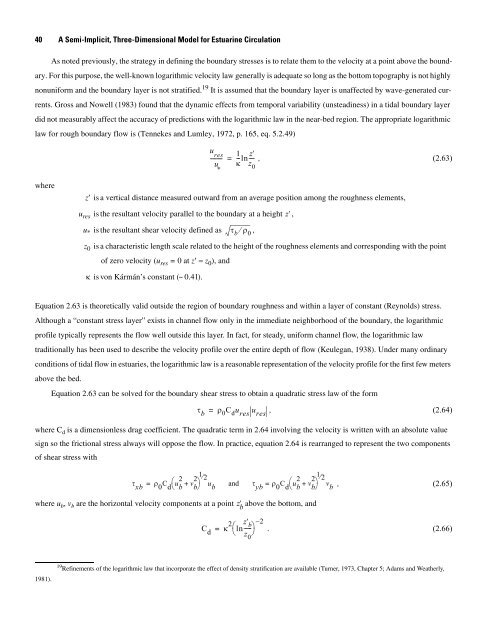A Semi-Implicit, Three-Dimensional Model for Estuarine ... - USGS
A Semi-Implicit, Three-Dimensional Model for Estuarine ... - USGS
A Semi-Implicit, Three-Dimensional Model for Estuarine ... - USGS
Create successful ePaper yourself
Turn your PDF publications into a flip-book with our unique Google optimized e-Paper software.
40 A <strong>Semi</strong>-<strong>Implicit</strong>, <strong>Three</strong>-<strong>Dimensional</strong> <strong>Model</strong> <strong>for</strong> <strong>Estuarine</strong> Circulation<br />
As noted previously, the strategy in defining the boundary stresses is to relate them to the velocity at a point above the bound-<br />
ary. For this purpose, the well-known logarithmic velocity law generally is adequate so long as the bottom topography is not highly<br />
nonuni<strong>for</strong>m and the boundary layer is not stratified. 19 It is assumed that the boundary layer is unaffected by wave-generated cur-<br />
rents. Gross and Nowell (1983) found that the dynamic effects from temporal variability (unsteadiness) in a tidal boundary layer<br />
did not measurably affect the accuracy of predictions with the logarithmic law in the near-bed region. The appropriate logarithmic<br />
law <strong>for</strong> rough boundary flow is (Tennekes and Lumley, 1972, p. 165, eq. 5.2.49)<br />
where<br />
u<br />
res<br />
-------- =<br />
u<br />
*<br />
1<br />
--ln<br />
κ<br />
z'<br />
---z0<br />
, (2.63)<br />
z′ is a vertical distance measured outward from an average position among the roughness elements,<br />
u res is the resultant velocity parallel to the boundary at a height z' ,<br />
u * is the resultant shear velocity defined as τb ⁄ ρ0 ,<br />
z 0 is a characteristic length scale related to the height of the roughness elements and corresponding with the point<br />
of zero velocity (u res = 0 at z′ = z 0 ), and<br />
κ is von Kármán’s constant (~ 0.41).<br />
Equation 2.63 is theoretically valid outside the region of boundary roughness and within a layer of constant (Reynolds) stress.<br />
Although a “constant stress layer” exists in channel flow only in the immediate neighborhood of the boundary, the logarithmic<br />
profile typically represents the flow well outside this layer. In fact, <strong>for</strong> steady, uni<strong>for</strong>m channel flow, the logarithmic law<br />
traditionally has been used to describe the velocity profile over the entire depth of flow (Keulegan, 1938). Under many ordinary<br />
conditions of tidal flow in estuaries, the logarithmic law is a reasonable representation of the velocity profile <strong>for</strong> the first few meters<br />
above the bed.<br />
Equation 2.63 can be solved <strong>for</strong> the boundary shear stress to obtain a quadratic stress law of the <strong>for</strong>m<br />
τ b<br />
= ρ0Cd u<br />
res<br />
u<br />
res<br />
, (2.64)<br />
where Cd is a dimensionless drag coefficient. The quadratic term in 2.64 involving the velocity is written with an absolute value<br />
sign so the frictional stress always will oppose the flow. In practice, equation 2.64 is rearranged to represent the two components<br />
of shear stress with<br />
τ<br />
xb<br />
ρ<br />
0<br />
C ⎛ 2 2<br />
d<br />
u<br />
b<br />
+ v ⎞<br />
⎝ b⎠<br />
1⁄ 2<br />
ub and τ<br />
yb<br />
ρ<br />
0<br />
C ⎛ 2 2<br />
d<br />
u<br />
b<br />
+ v ⎞<br />
⎝ b⎠<br />
1⁄ 2<br />
= =<br />
vb , (2.65)<br />
where u b, v b are the horizontal velocity components at a point z' b above the bottom, and<br />
1981).<br />
C d<br />
κ 2 ln z' ⎛ b<br />
----- ⎞<br />
⎝ z ⎠<br />
0<br />
2 –<br />
= . (2.66)<br />
19 Refinements of the logarithmic law that incorporate the effect of density stratification are available (Turner, 1973, Chapter 5; Adams and Weatherly,

















